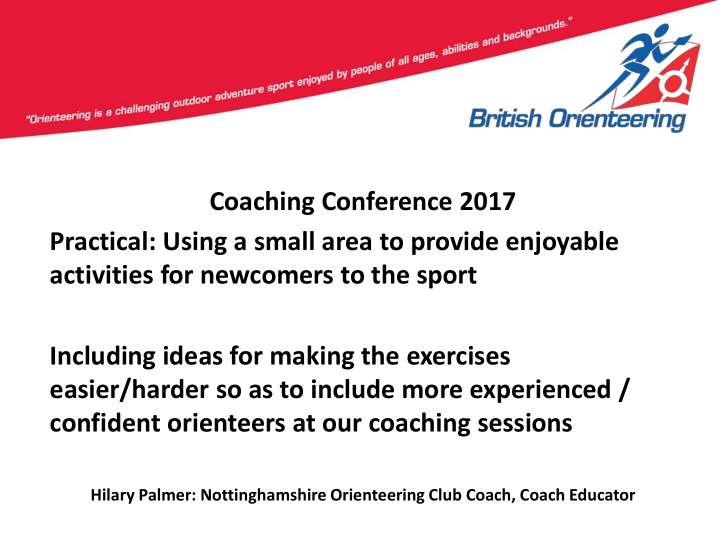



Coaching Conference 2017 Practical: Using a small area to provide enjoyable activities for newcomers to the sport Including ideas for making the exercises easier/harder so as to include more experienced / confident orienteers at our coaching sessions Hilary Palmer: Nottinghamshire Orienteering Club Coach, Coach Educator
Progression Newcomers: usual progression is map walk, star, loops This practical will look at some ideas for variations on the usual star / loops theme + ideas for including a variety of participants STEP mnemonic helps: change the Space, Task, Equipment, People to make exercises easier / harder 2
Clock Relay Fun game for any level of experience: V1: Easy/control sites nearby - with stakes at control site to hang team markers (different smiley suns) V2: Harder - No controls/stakes in terrain so people have to be confident they are at the control site
Clock Relay • Pairs take turns to place marker • Person 1 places marker & gives map to P2 • P2 moves marker from # 1 > 2 • P2 gives map to P1 • P1 moves marker from #2 > 3 Differentiate: Distances away; stake at control site or not; map ‘windows’ instead of full map; map memory
Pairs place cone & retrieve partner’s No controls in the terrain – a progression which newcomers can do after a few sessions in the area finding controls (map walk, star, loops to get them started) This example with 5 pairs of controls: A & A2 etc
Pairs place cone & retrieve partner’s • Each pair has different markers eg 2 red cones, 2 yellow cones, 2 blue cones with number 1 etc etc. • Each person places marker, returns to start, swaps map and retrieves partner’s marker. • Differentiation: – Plan control sites at varying distances/difficulty for mixed group – both markers on the same map: place own marker then race to collect partner’s marker and get back to start (this is called the Peter Palmer Challenge – named after our first Director of Coaching, Peter Palmer) – ‘window’ or ‘corridors’ maps instead of full maps 6
Pairs place cone & retrieve partner’s
Pairs take turns to navigate • Relocation exercise in pairs: – Person A navigates to control 1 on Map A – Person B works out where they are and navigates to control 1 on Map B – In this area there were permanent markers at each control site; alternatively coach must hang controls – Maps and starting controls were pre-marked on maps so that teams started in different directions • Differentiation: Full map could be used; we used a ‘windows’ map for more experienced people or when they have got used to an area over time . N.B. take care over cutting the ‘windows’ not to exclude vital information (for navigation or safety) 8
Pairs take turns to navigate 9
Pairs take turns to navigate 10
Recommend
More recommend